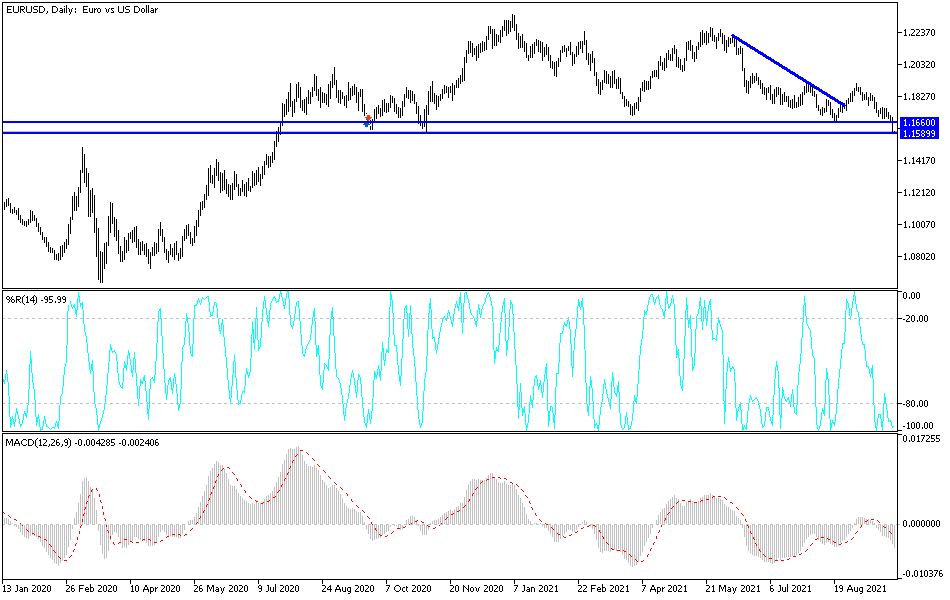Wednesday's session was particularly bearish for the EUR/USD, which fell to the 1.1589 support level from the 1.1690 resistance in the same session. It was the worst daily performance in more than two months. The pair is stable around the 14-month low ahead of the last trading session for the third quarter of 2021, amid anticipation of a package of important European and American economic releases. The US dollar is still receiving more impetus from expectations of raising US interest rates at a time when other central banks, such as the European Central Bank, are facing obstacles to do so, a situation that may continue for years as long as the epidemic persists. Weak economic data results from the Eurozone, especially Germany, continue to negatively affect investor sentiment towards the euro.
Rising bond yields and declining markets are telling us that investors fear that inflation will continue to rise and that central banks will inevitably have to raise interest rates. Thus, the niche for global markets with high growth and low inflation may be over, but some analysts say this wave of investor unease will be temporary.
“You know something is wrong when stocks and bonds are selling at a steady pace,” says Matthias van der Geogt, analyst at KBC Markets. The simple answer is the fear that structurally high inflation risks weigh on growth.” This observation applies to the United Kingdom and the British pound in particular, where the rise in inflation linked to the energy crisis appears to be more severe than in Europe, the United States and other countries.
The US 10-year bond yield rose above 1.52% while the British 10-year bond yield exceeded 1.0%. The stock markets sank and the US dollar proved to be the main beneficiary.
Inflation risks becoming structural as consumers and businesses react to persistently high inflation caused by the type of supply shocks we are currently experiencing. BoE Governor Andrew Bailey expressed his concerns about this development in a speech this week where he said that inflation could become self-sustaining and therefore require central bank intervention. In his testimony before the Senate Banking Committee on Tuesday, US Federal Reserve Chairman Jerome Powell said:
“Bottlenecks, staffing difficulties and other constraints could once again prove larger and more permanent than anticipated, posing upward risks to inflation. If persistently high inflation becomes a major concern, we will certainly respond and use our tools to ensure inflation is operating at levels consistent with our objective.”
For his part, Michael Brown, chief market analyst at CaxtonFX, says that bond market behavior "is a classic sign of market pricing under a tighter monetary policy, both through tapering and eventually raising prices." But Brown says he still views the rise in inflation to remain ultimately temporary in nature, a view echoed by Federal Reserve Chair Jerome Powell.
Investors were naturally drawn to Powell's comments about the potential for inflation to become more structural, understandable on a day of falling stock markets and rising bond yields. But he said, "These effects were larger and longer-lasting than expected, but they will decline, and as it happens, inflation is expected to decline again towards our long-term target of 2 percent."
Technical analysis of the pair
The recent and continuous losses of the EUR/USD pushed technical indicators towards strong oversold levels, which is evident on the 4-hour and daily charts. The decline motivates Forex investors to buy again until a rebound upward. The support levels at 1.1585, 1.1500 and 1.1425 are optimal for that. On the upside, according to the performance on the daily chart, the nearest important resistances are 1.1745 and 1.1830. Otherwise, the general trend of the pair will remain to the downside.
For the euro, there will be the release of German, French and Italian consumer prices, German unemployment numbers and Eurozone unemployment numbers. From the United States of America, the growth rate of the US economy, the number of jobless claims, and a series of statements by US monetary policy officials will be announced.

